Holmes Institute HA3042 Taxation Law Individual Assignment T2 2019
VerifiedAdded on 2022/10/17
|12
|2864
|20
Homework Assignment
AI Summary
This taxation law assignment addresses key concepts in Australian taxation, focusing on Capital Gains Tax (CGT) and depreciation. The assignment analyzes different scenarios, including the sale of a main house, a car, a cleaning business, furniture, and paintings, to determine CGT implications. It also explores the tax deductions related to depreciating assets, specifically examining the case of a manufacturing business that purchased a CNC machine. The analysis covers relevant sections of the Income Tax Assessment Act 1997 (ITAA 97), including provisions related to personal use assets, small business entities, and the cost base of depreciating assets. The assignment applies legal principles to practical situations, providing detailed explanations and referencing relevant case law to support its conclusions.
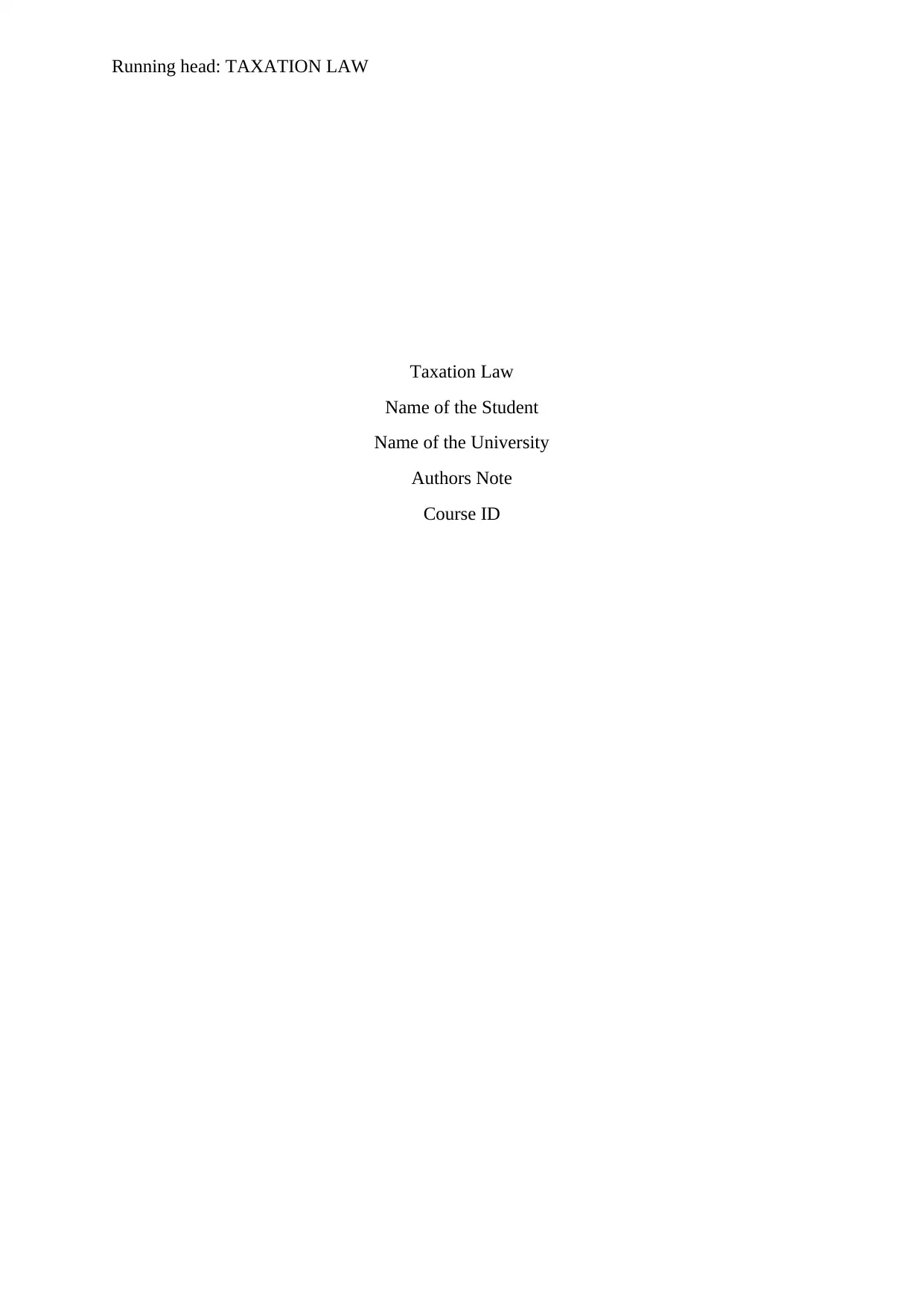
Running head: TAXATION LAW
Taxation Law
Name of the Student
Name of the University
Authors Note
Course ID
Taxation Law
Name of the Student
Name of the University
Authors Note
Course ID
Paraphrase This Document
Need a fresh take? Get an instant paraphrase of this document with our AI Paraphraser
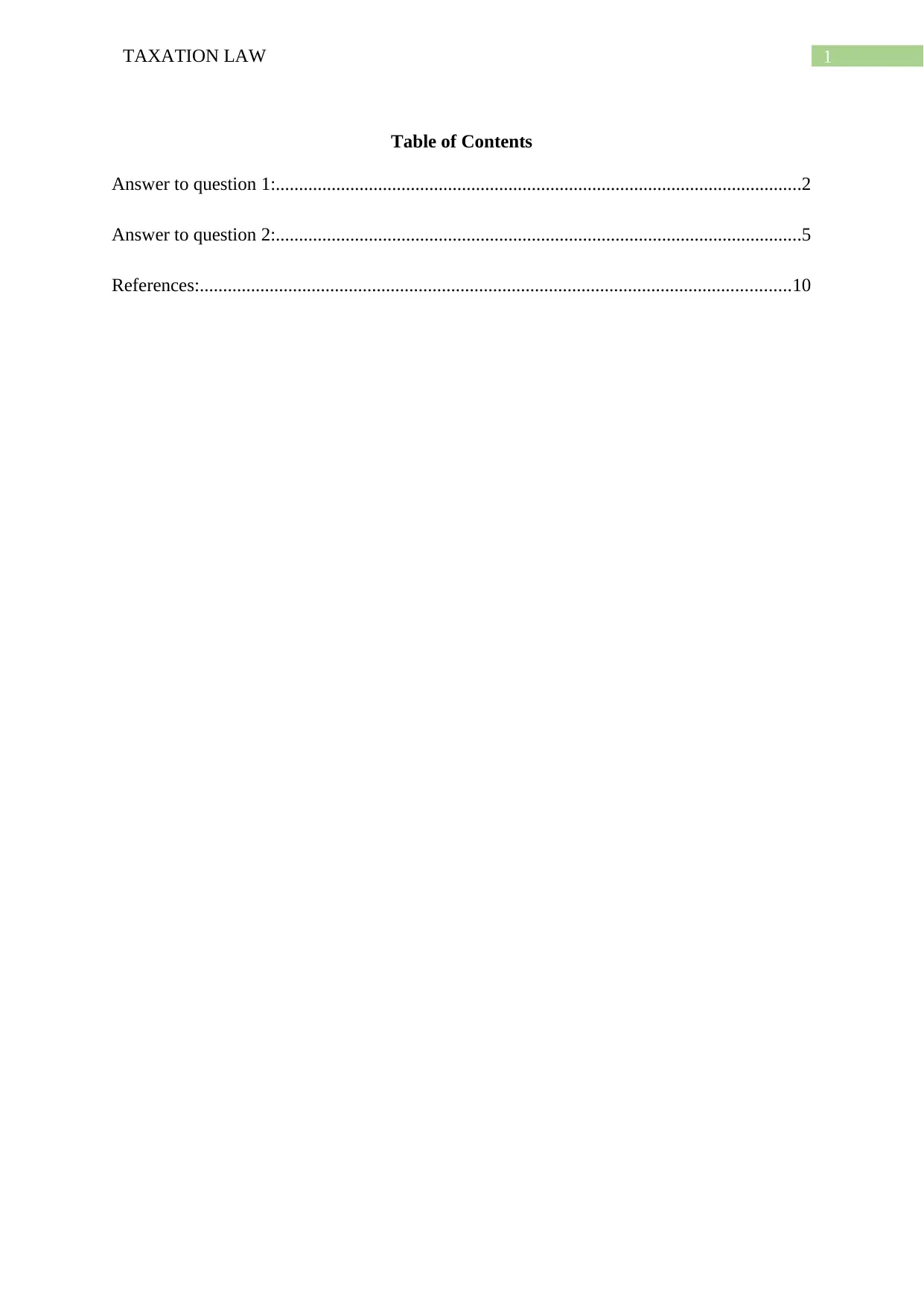
1TAXATION LAW
Table of Contents
Answer to question 1:.................................................................................................................2
Answer to question 2:.................................................................................................................5
References:...............................................................................................................................10
Table of Contents
Answer to question 1:.................................................................................................................2
Answer to question 2:.................................................................................................................5
References:...............................................................................................................................10
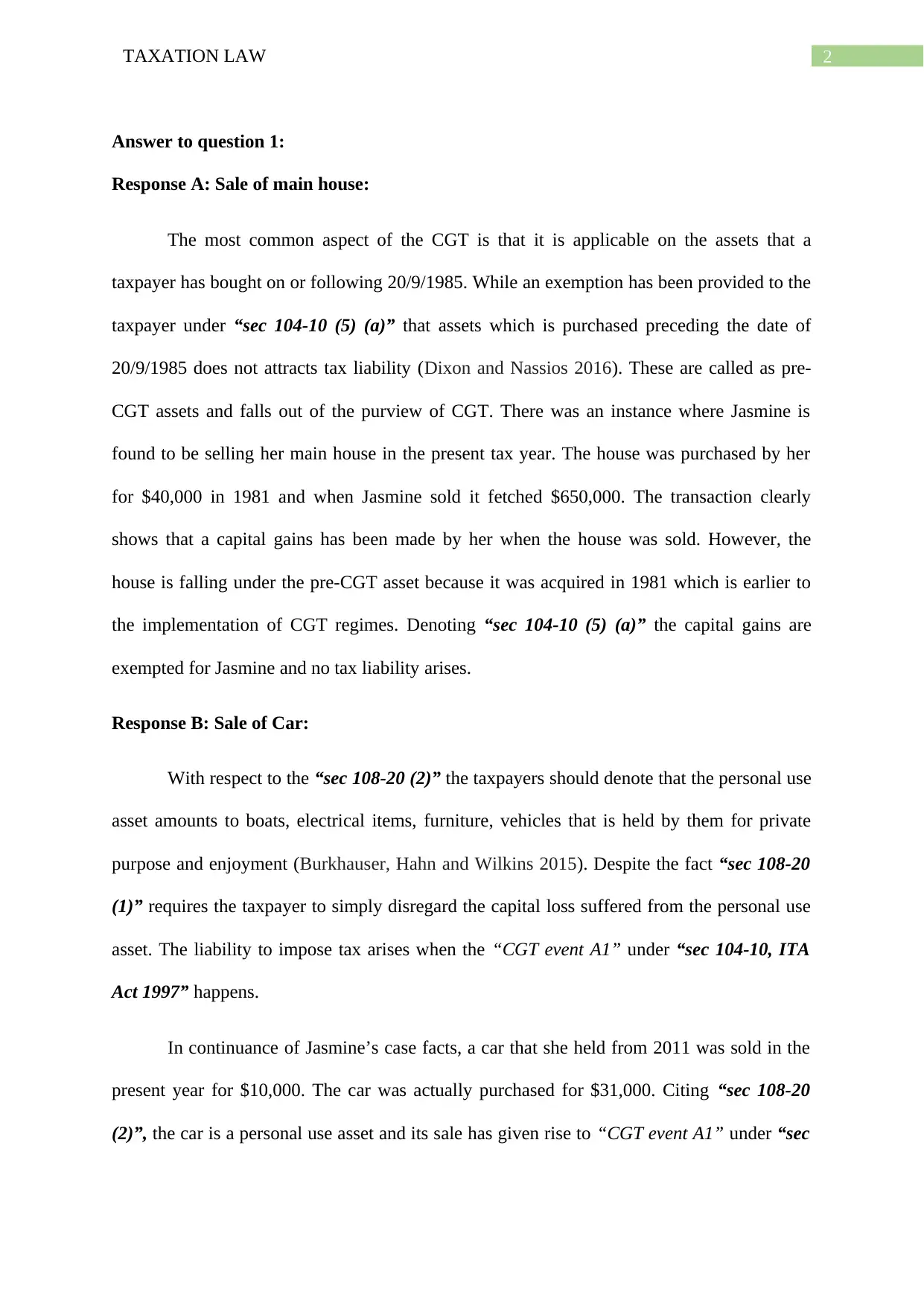
2TAXATION LAW
Answer to question 1:
Response A: Sale of main house:
The most common aspect of the CGT is that it is applicable on the assets that a
taxpayer has bought on or following 20/9/1985. While an exemption has been provided to the
taxpayer under “sec 104-10 (5) (a)” that assets which is purchased preceding the date of
20/9/1985 does not attracts tax liability (Dixon and Nassios 2016). These are called as pre-
CGT assets and falls out of the purview of CGT. There was an instance where Jasmine is
found to be selling her main house in the present tax year. The house was purchased by her
for $40,000 in 1981 and when Jasmine sold it fetched $650,000. The transaction clearly
shows that a capital gains has been made by her when the house was sold. However, the
house is falling under the pre-CGT asset because it was acquired in 1981 which is earlier to
the implementation of CGT regimes. Denoting “sec 104-10 (5) (a)” the capital gains are
exempted for Jasmine and no tax liability arises.
Response B: Sale of Car:
With respect to the “sec 108-20 (2)” the taxpayers should denote that the personal use
asset amounts to boats, electrical items, furniture, vehicles that is held by them for private
purpose and enjoyment (Burkhauser, Hahn and Wilkins 2015). Despite the fact “sec 108-20
(1)” requires the taxpayer to simply disregard the capital loss suffered from the personal use
asset. The liability to impose tax arises when the “CGT event A1” under “sec 104-10, ITA
Act 1997” happens.
In continuance of Jasmine’s case facts, a car that she held from 2011 was sold in the
present year for $10,000. The car was actually purchased for $31,000. Citing “sec 108-20
(2)”, the car is a personal use asset and its sale has given rise to “CGT event A1” under “sec
Answer to question 1:
Response A: Sale of main house:
The most common aspect of the CGT is that it is applicable on the assets that a
taxpayer has bought on or following 20/9/1985. While an exemption has been provided to the
taxpayer under “sec 104-10 (5) (a)” that assets which is purchased preceding the date of
20/9/1985 does not attracts tax liability (Dixon and Nassios 2016). These are called as pre-
CGT assets and falls out of the purview of CGT. There was an instance where Jasmine is
found to be selling her main house in the present tax year. The house was purchased by her
for $40,000 in 1981 and when Jasmine sold it fetched $650,000. The transaction clearly
shows that a capital gains has been made by her when the house was sold. However, the
house is falling under the pre-CGT asset because it was acquired in 1981 which is earlier to
the implementation of CGT regimes. Denoting “sec 104-10 (5) (a)” the capital gains are
exempted for Jasmine and no tax liability arises.
Response B: Sale of Car:
With respect to the “sec 108-20 (2)” the taxpayers should denote that the personal use
asset amounts to boats, electrical items, furniture, vehicles that is held by them for private
purpose and enjoyment (Burkhauser, Hahn and Wilkins 2015). Despite the fact “sec 108-20
(1)” requires the taxpayer to simply disregard the capital loss suffered from the personal use
asset. The liability to impose tax arises when the “CGT event A1” under “sec 104-10, ITA
Act 1997” happens.
In continuance of Jasmine’s case facts, a car that she held from 2011 was sold in the
present year for $10,000. The car was actually purchased for $31,000. Citing “sec 108-20
(2)”, the car is a personal use asset and its sale has given rise to “CGT event A1” under “sec
⊘ This is a preview!⊘
Do you want full access?
Subscribe today to unlock all pages.

Trusted by 1+ million students worldwide
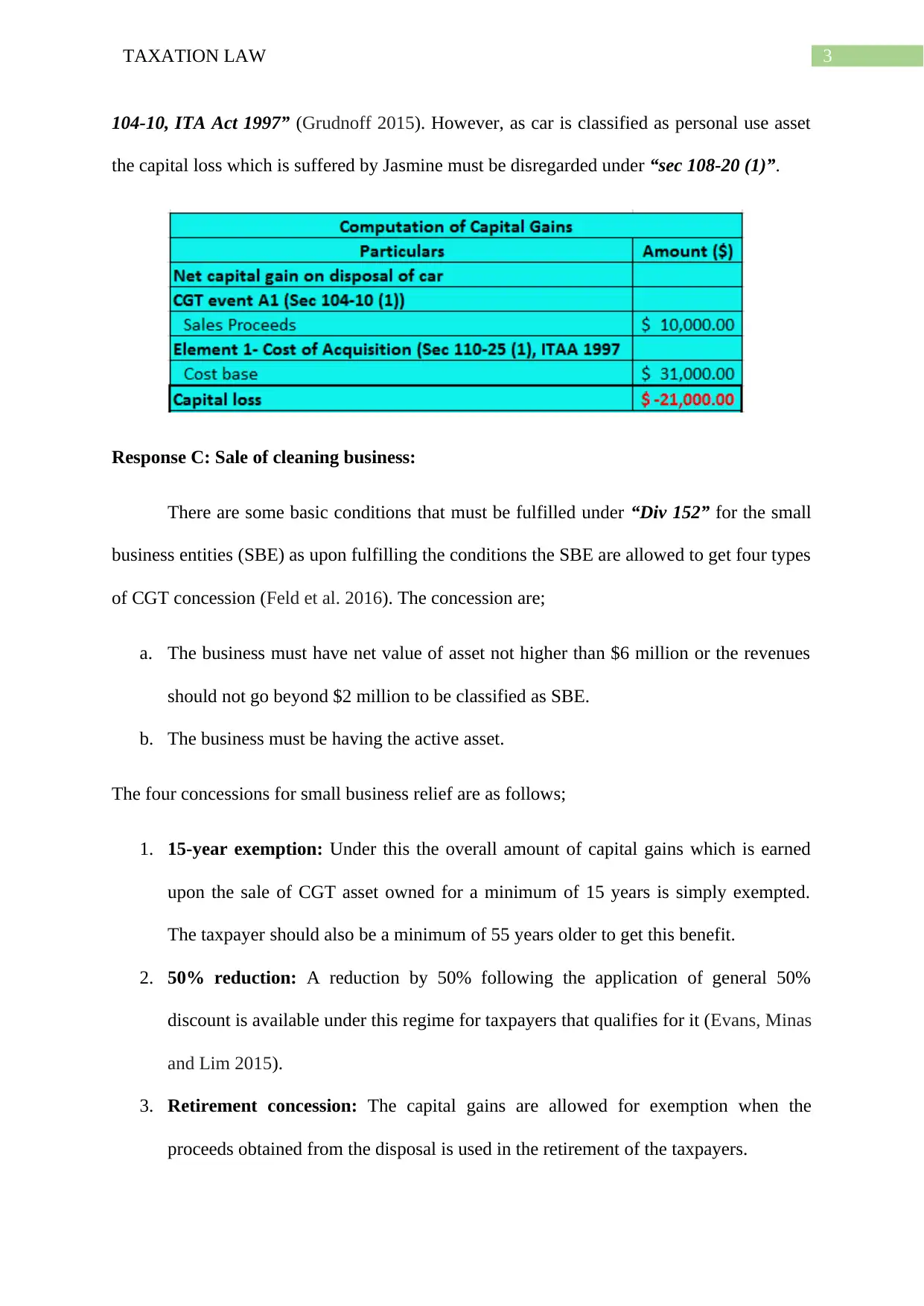
3TAXATION LAW
104-10, ITA Act 1997” (Grudnoff 2015). However, as car is classified as personal use asset
the capital loss which is suffered by Jasmine must be disregarded under “sec 108-20 (1)”.
Response C: Sale of cleaning business:
There are some basic conditions that must be fulfilled under “Div 152” for the small
business entities (SBE) as upon fulfilling the conditions the SBE are allowed to get four types
of CGT concession (Feld et al. 2016). The concession are;
a. The business must have net value of asset not higher than $6 million or the revenues
should not go beyond $2 million to be classified as SBE.
b. The business must be having the active asset.
The four concessions for small business relief are as follows;
1. 15-year exemption: Under this the overall amount of capital gains which is earned
upon the sale of CGT asset owned for a minimum of 15 years is simply exempted.
The taxpayer should also be a minimum of 55 years older to get this benefit.
2. 50% reduction: A reduction by 50% following the application of general 50%
discount is available under this regime for taxpayers that qualifies for it (Evans, Minas
and Lim 2015).
3. Retirement concession: The capital gains are allowed for exemption when the
proceeds obtained from the disposal is used in the retirement of the taxpayers.
104-10, ITA Act 1997” (Grudnoff 2015). However, as car is classified as personal use asset
the capital loss which is suffered by Jasmine must be disregarded under “sec 108-20 (1)”.
Response C: Sale of cleaning business:
There are some basic conditions that must be fulfilled under “Div 152” for the small
business entities (SBE) as upon fulfilling the conditions the SBE are allowed to get four types
of CGT concession (Feld et al. 2016). The concession are;
a. The business must have net value of asset not higher than $6 million or the revenues
should not go beyond $2 million to be classified as SBE.
b. The business must be having the active asset.
The four concessions for small business relief are as follows;
1. 15-year exemption: Under this the overall amount of capital gains which is earned
upon the sale of CGT asset owned for a minimum of 15 years is simply exempted.
The taxpayer should also be a minimum of 55 years older to get this benefit.
2. 50% reduction: A reduction by 50% following the application of general 50%
discount is available under this regime for taxpayers that qualifies for it (Evans, Minas
and Lim 2015).
3. Retirement concession: The capital gains are allowed for exemption when the
proceeds obtained from the disposal is used in the retirement of the taxpayers.
Paraphrase This Document
Need a fresh take? Get an instant paraphrase of this document with our AI Paraphraser
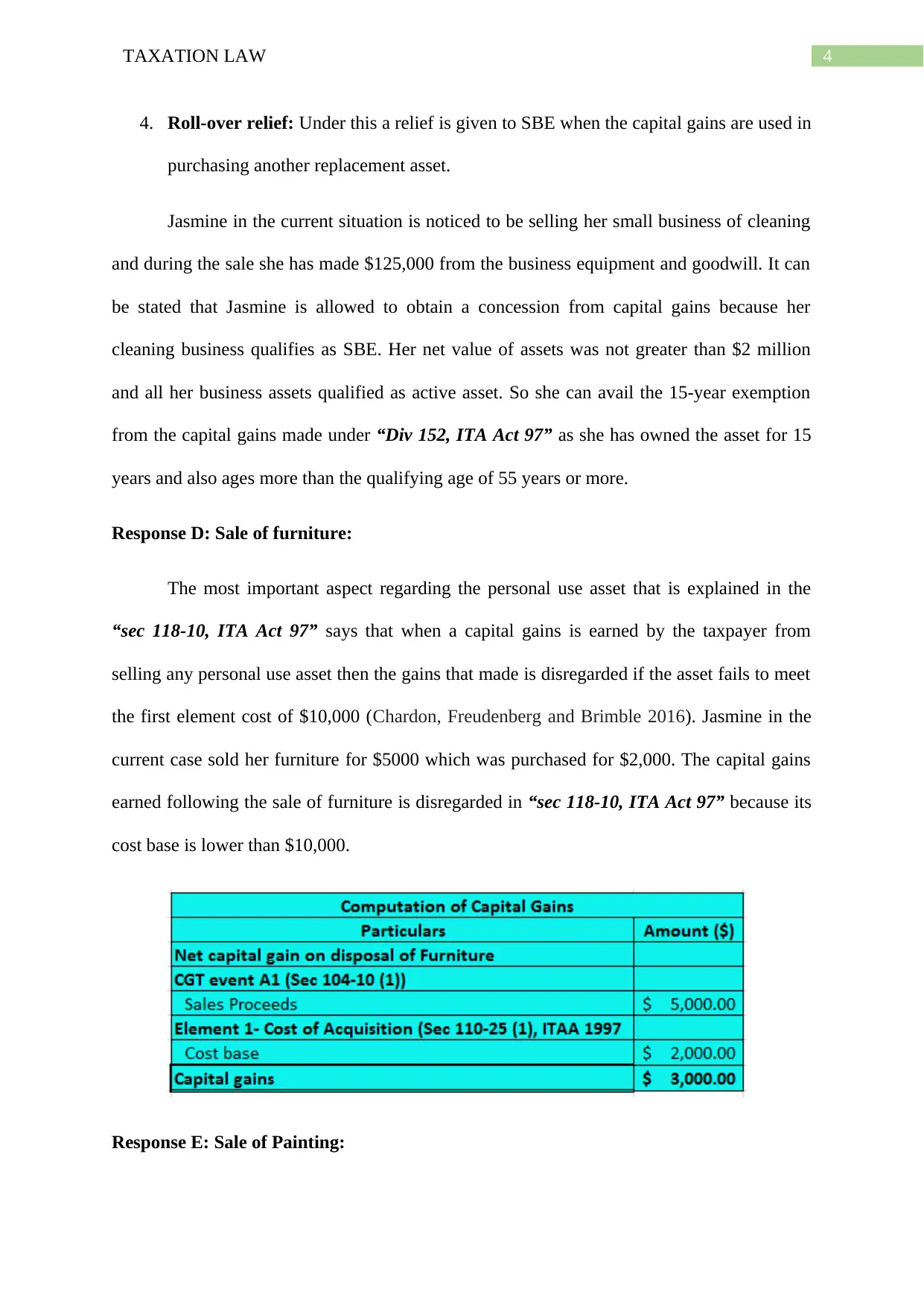
4TAXATION LAW
4. Roll-over relief: Under this a relief is given to SBE when the capital gains are used in
purchasing another replacement asset.
Jasmine in the current situation is noticed to be selling her small business of cleaning
and during the sale she has made $125,000 from the business equipment and goodwill. It can
be stated that Jasmine is allowed to obtain a concession from capital gains because her
cleaning business qualifies as SBE. Her net value of assets was not greater than $2 million
and all her business assets qualified as active asset. So she can avail the 15-year exemption
from the capital gains made under “Div 152, ITA Act 97” as she has owned the asset for 15
years and also ages more than the qualifying age of 55 years or more.
Response D: Sale of furniture:
The most important aspect regarding the personal use asset that is explained in the
“sec 118-10, ITA Act 97” says that when a capital gains is earned by the taxpayer from
selling any personal use asset then the gains that made is disregarded if the asset fails to meet
the first element cost of $10,000 (Chardon, Freudenberg and Brimble 2016). Jasmine in the
current case sold her furniture for $5000 which was purchased for $2,000. The capital gains
earned following the sale of furniture is disregarded in “sec 118-10, ITA Act 97” because its
cost base is lower than $10,000.
Response E: Sale of Painting:
4. Roll-over relief: Under this a relief is given to SBE when the capital gains are used in
purchasing another replacement asset.
Jasmine in the current situation is noticed to be selling her small business of cleaning
and during the sale she has made $125,000 from the business equipment and goodwill. It can
be stated that Jasmine is allowed to obtain a concession from capital gains because her
cleaning business qualifies as SBE. Her net value of assets was not greater than $2 million
and all her business assets qualified as active asset. So she can avail the 15-year exemption
from the capital gains made under “Div 152, ITA Act 97” as she has owned the asset for 15
years and also ages more than the qualifying age of 55 years or more.
Response D: Sale of furniture:
The most important aspect regarding the personal use asset that is explained in the
“sec 118-10, ITA Act 97” says that when a capital gains is earned by the taxpayer from
selling any personal use asset then the gains that made is disregarded if the asset fails to meet
the first element cost of $10,000 (Chardon, Freudenberg and Brimble 2016). Jasmine in the
current case sold her furniture for $5000 which was purchased for $2,000. The capital gains
earned following the sale of furniture is disregarded in “sec 118-10, ITA Act 97” because its
cost base is lower than $10,000.
Response E: Sale of Painting:
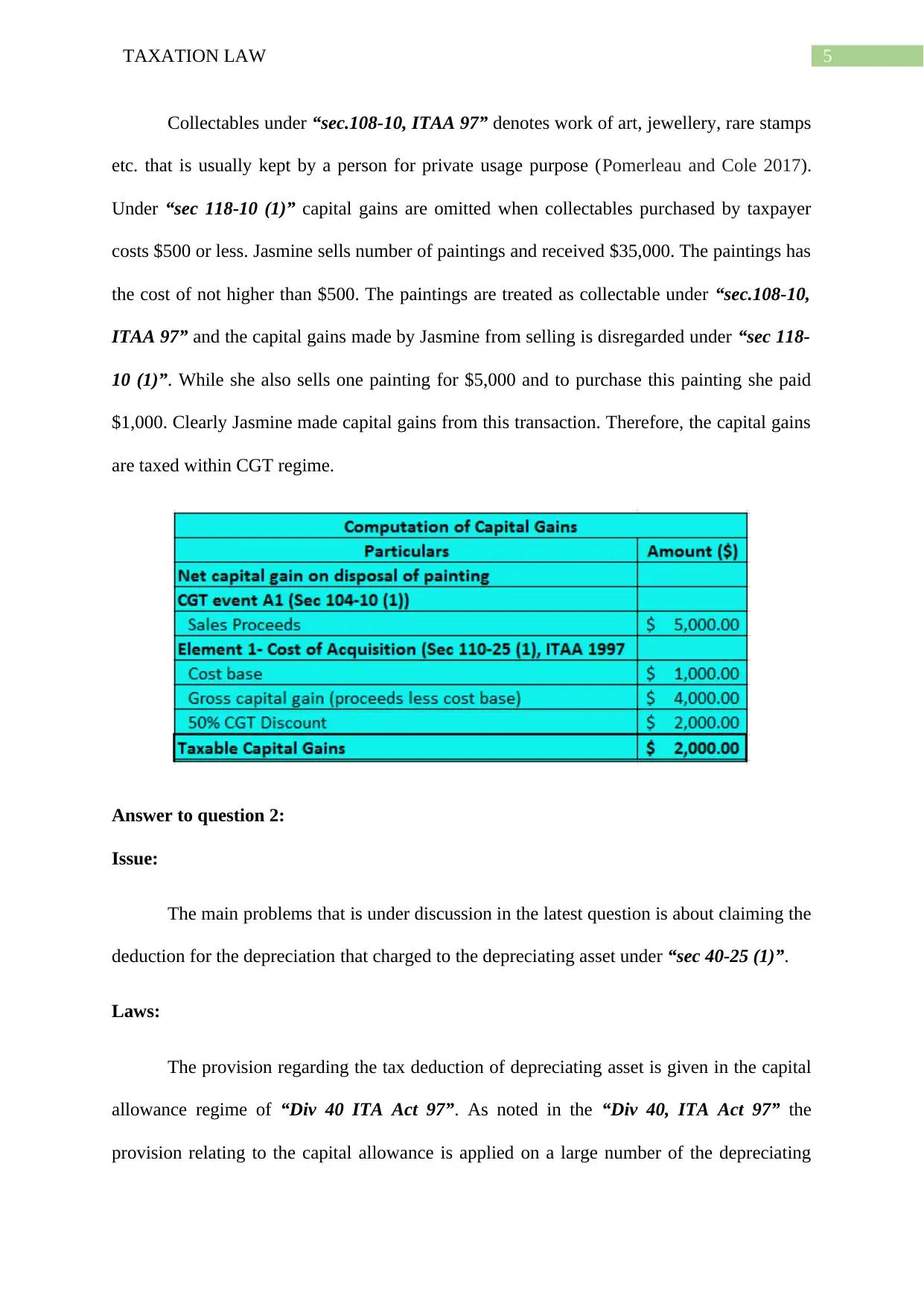
5TAXATION LAW
Collectables under “sec.108-10, ITAA 97” denotes work of art, jewellery, rare stamps
etc. that is usually kept by a person for private usage purpose (Pomerleau and Cole 2017).
Under “sec 118-10 (1)” capital gains are omitted when collectables purchased by taxpayer
costs $500 or less. Jasmine sells number of paintings and received $35,000. The paintings has
the cost of not higher than $500. The paintings are treated as collectable under “sec.108-10,
ITAA 97” and the capital gains made by Jasmine from selling is disregarded under “sec 118-
10 (1)”. While she also sells one painting for $5,000 and to purchase this painting she paid
$1,000. Clearly Jasmine made capital gains from this transaction. Therefore, the capital gains
are taxed within CGT regime.
Answer to question 2:
Issue:
The main problems that is under discussion in the latest question is about claiming the
deduction for the depreciation that charged to the depreciating asset under “sec 40-25 (1)”.
Laws:
The provision regarding the tax deduction of depreciating asset is given in the capital
allowance regime of “Div 40 ITA Act 97”. As noted in the “Div 40, ITA Act 97” the
provision relating to the capital allowance is applied on a large number of the depreciating
Collectables under “sec.108-10, ITAA 97” denotes work of art, jewellery, rare stamps
etc. that is usually kept by a person for private usage purpose (Pomerleau and Cole 2017).
Under “sec 118-10 (1)” capital gains are omitted when collectables purchased by taxpayer
costs $500 or less. Jasmine sells number of paintings and received $35,000. The paintings has
the cost of not higher than $500. The paintings are treated as collectable under “sec.108-10,
ITAA 97” and the capital gains made by Jasmine from selling is disregarded under “sec 118-
10 (1)”. While she also sells one painting for $5,000 and to purchase this painting she paid
$1,000. Clearly Jasmine made capital gains from this transaction. Therefore, the capital gains
are taxed within CGT regime.
Answer to question 2:
Issue:
The main problems that is under discussion in the latest question is about claiming the
deduction for the depreciation that charged to the depreciating asset under “sec 40-25 (1)”.
Laws:
The provision regarding the tax deduction of depreciating asset is given in the capital
allowance regime of “Div 40 ITA Act 97”. As noted in the “Div 40, ITA Act 97” the
provision relating to the capital allowance is applied on a large number of the depreciating
⊘ This is a preview!⊘
Do you want full access?
Subscribe today to unlock all pages.

Trusted by 1+ million students worldwide
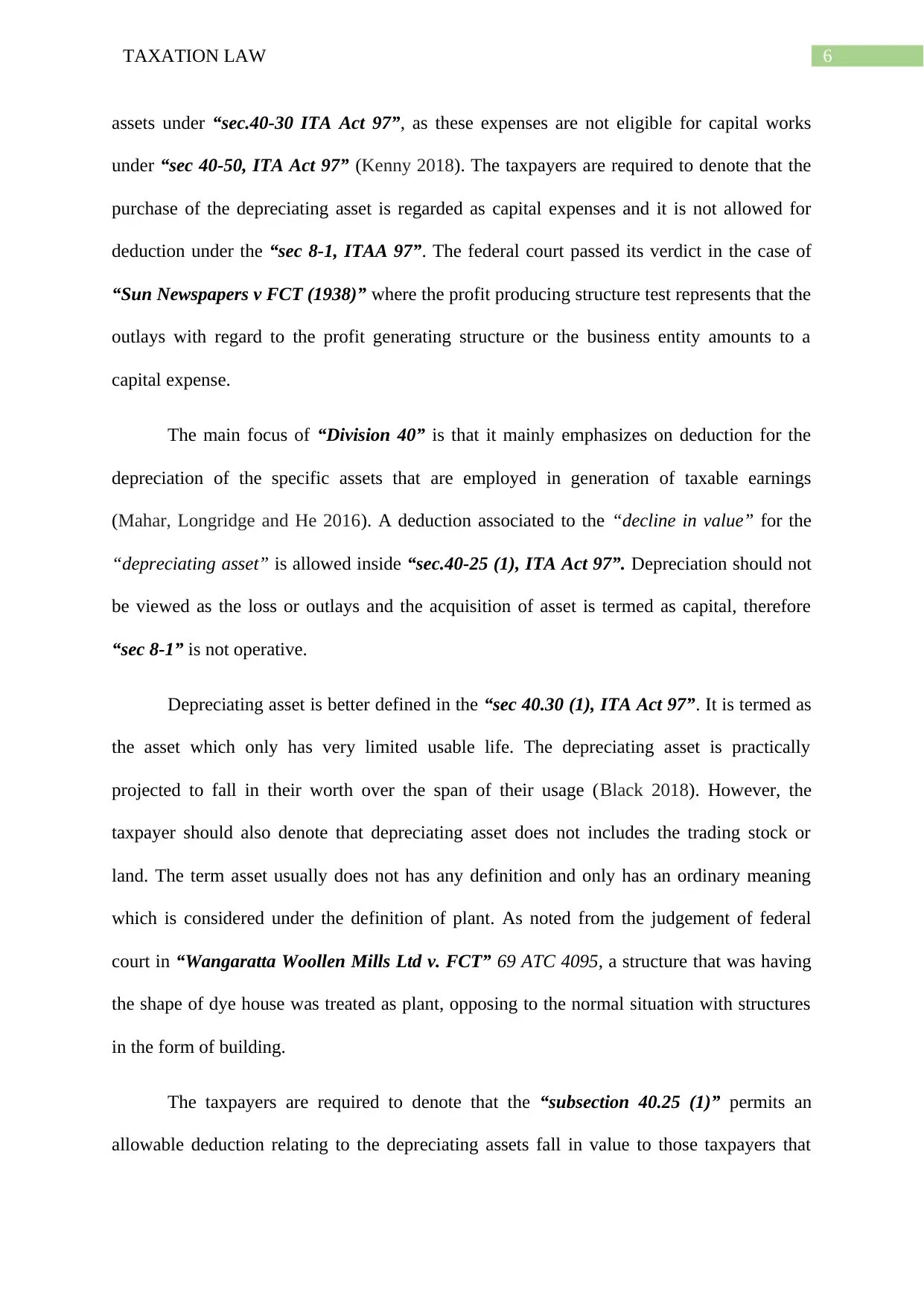
6TAXATION LAW
assets under “sec.40-30 ITA Act 97”, as these expenses are not eligible for capital works
under “sec 40-50, ITA Act 97” (Kenny 2018). The taxpayers are required to denote that the
purchase of the depreciating asset is regarded as capital expenses and it is not allowed for
deduction under the “sec 8-1, ITAA 97”. The federal court passed its verdict in the case of
“Sun Newspapers v FCT (1938)” where the profit producing structure test represents that the
outlays with regard to the profit generating structure or the business entity amounts to a
capital expense.
The main focus of “Division 40” is that it mainly emphasizes on deduction for the
depreciation of the specific assets that are employed in generation of taxable earnings
(Mahar, Longridge and He 2016). A deduction associated to the “decline in value” for the
“depreciating asset” is allowed inside “sec.40-25 (1), ITA Act 97”. Depreciation should not
be viewed as the loss or outlays and the acquisition of asset is termed as capital, therefore
“sec 8-1” is not operative.
Depreciating asset is better defined in the “sec 40.30 (1), ITA Act 97”. It is termed as
the asset which only has very limited usable life. The depreciating asset is practically
projected to fall in their worth over the span of their usage (Black 2018). However, the
taxpayer should also denote that depreciating asset does not includes the trading stock or
land. The term asset usually does not has any definition and only has an ordinary meaning
which is considered under the definition of plant. As noted from the judgement of federal
court in “Wangaratta Woollen Mills Ltd v. FCT” 69 ATC 4095, a structure that was having
the shape of dye house was treated as plant, opposing to the normal situation with structures
in the form of building.
The taxpayers are required to denote that the “subsection 40.25 (1)” permits an
allowable deduction relating to the depreciating assets fall in value to those taxpayers that
assets under “sec.40-30 ITA Act 97”, as these expenses are not eligible for capital works
under “sec 40-50, ITA Act 97” (Kenny 2018). The taxpayers are required to denote that the
purchase of the depreciating asset is regarded as capital expenses and it is not allowed for
deduction under the “sec 8-1, ITAA 97”. The federal court passed its verdict in the case of
“Sun Newspapers v FCT (1938)” where the profit producing structure test represents that the
outlays with regard to the profit generating structure or the business entity amounts to a
capital expense.
The main focus of “Division 40” is that it mainly emphasizes on deduction for the
depreciation of the specific assets that are employed in generation of taxable earnings
(Mahar, Longridge and He 2016). A deduction associated to the “decline in value” for the
“depreciating asset” is allowed inside “sec.40-25 (1), ITA Act 97”. Depreciation should not
be viewed as the loss or outlays and the acquisition of asset is termed as capital, therefore
“sec 8-1” is not operative.
Depreciating asset is better defined in the “sec 40.30 (1), ITA Act 97”. It is termed as
the asset which only has very limited usable life. The depreciating asset is practically
projected to fall in their worth over the span of their usage (Black 2018). However, the
taxpayer should also denote that depreciating asset does not includes the trading stock or
land. The term asset usually does not has any definition and only has an ordinary meaning
which is considered under the definition of plant. As noted from the judgement of federal
court in “Wangaratta Woollen Mills Ltd v. FCT” 69 ATC 4095, a structure that was having
the shape of dye house was treated as plant, opposing to the normal situation with structures
in the form of building.
The taxpayers are required to denote that the “subsection 40.25 (1)” permits an
allowable deduction relating to the depreciating assets fall in value to those taxpayers that
Paraphrase This Document
Need a fresh take? Get an instant paraphrase of this document with our AI Paraphraser
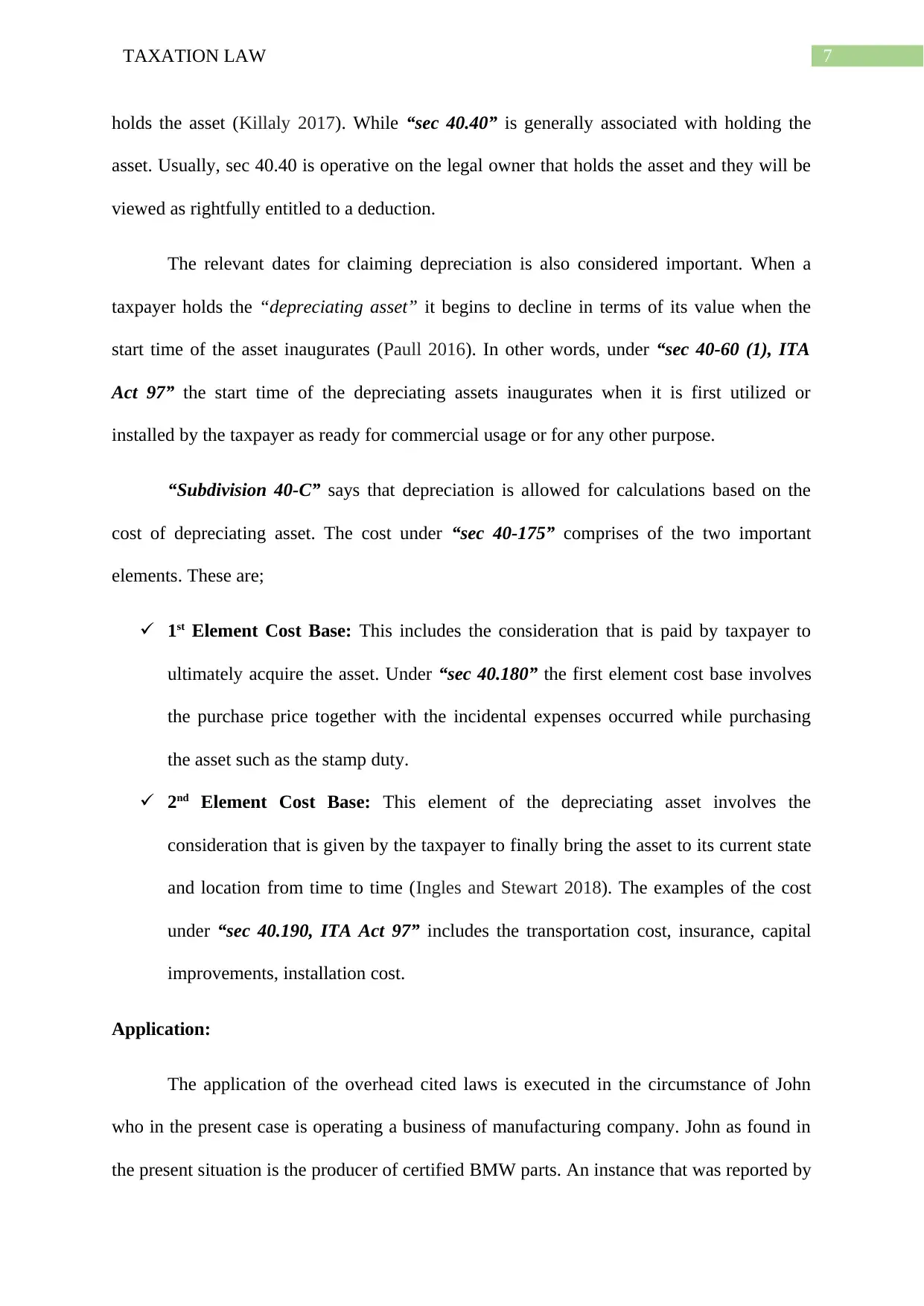
7TAXATION LAW
holds the asset (Killaly 2017). While “sec 40.40” is generally associated with holding the
asset. Usually, sec 40.40 is operative on the legal owner that holds the asset and they will be
viewed as rightfully entitled to a deduction.
The relevant dates for claiming depreciation is also considered important. When a
taxpayer holds the “depreciating asset” it begins to decline in terms of its value when the
start time of the asset inaugurates (Paull 2016). In other words, under “sec 40-60 (1), ITA
Act 97” the start time of the depreciating assets inaugurates when it is first utilized or
installed by the taxpayer as ready for commercial usage or for any other purpose.
“Subdivision 40-C” says that depreciation is allowed for calculations based on the
cost of depreciating asset. The cost under “sec 40-175” comprises of the two important
elements. These are;
1st Element Cost Base: This includes the consideration that is paid by taxpayer to
ultimately acquire the asset. Under “sec 40.180” the first element cost base involves
the purchase price together with the incidental expenses occurred while purchasing
the asset such as the stamp duty.
2nd Element Cost Base: This element of the depreciating asset involves the
consideration that is given by the taxpayer to finally bring the asset to its current state
and location from time to time (Ingles and Stewart 2018). The examples of the cost
under “sec 40.190, ITA Act 97” includes the transportation cost, insurance, capital
improvements, installation cost.
Application:
The application of the overhead cited laws is executed in the circumstance of John
who in the present case is operating a business of manufacturing company. John as found in
the present situation is the producer of certified BMW parts. An instance that was reported by
holds the asset (Killaly 2017). While “sec 40.40” is generally associated with holding the
asset. Usually, sec 40.40 is operative on the legal owner that holds the asset and they will be
viewed as rightfully entitled to a deduction.
The relevant dates for claiming depreciation is also considered important. When a
taxpayer holds the “depreciating asset” it begins to decline in terms of its value when the
start time of the asset inaugurates (Paull 2016). In other words, under “sec 40-60 (1), ITA
Act 97” the start time of the depreciating assets inaugurates when it is first utilized or
installed by the taxpayer as ready for commercial usage or for any other purpose.
“Subdivision 40-C” says that depreciation is allowed for calculations based on the
cost of depreciating asset. The cost under “sec 40-175” comprises of the two important
elements. These are;
1st Element Cost Base: This includes the consideration that is paid by taxpayer to
ultimately acquire the asset. Under “sec 40.180” the first element cost base involves
the purchase price together with the incidental expenses occurred while purchasing
the asset such as the stamp duty.
2nd Element Cost Base: This element of the depreciating asset involves the
consideration that is given by the taxpayer to finally bring the asset to its current state
and location from time to time (Ingles and Stewart 2018). The examples of the cost
under “sec 40.190, ITA Act 97” includes the transportation cost, insurance, capital
improvements, installation cost.
Application:
The application of the overhead cited laws is executed in the circumstance of John
who in the present case is operating a business of manufacturing company. John as found in
the present situation is the producer of certified BMW parts. An instance that was reported by

8TAXATION LAW
him includes a visit to CNC machine factory in Germany. The machine was ultimately
acquired by John in consideration of $300,000. The CNC machine which John has purchased
is regarded as the depreciating capital asset and hence the cost paid is not allowed for
deduction under operative provision of “sec 8-1, ITA Act 97”. Citing “Sun Newspaper v
FCT (1938)” the CNC machine is a profit yielding structure and the expenses incurred by
John is capital in nature.
All the same, John must refer to the “Division 40, ITA Act 97” that deals with capital
allowance of depreciating assed used in generation of taxable earnings. A deduction for
decline in value of CNC machine under “sec 40.25 (1)” will be permitted to John since
depreciation cannot be termed as loss or outlays. Also under “sec 40.30 (1)” the CNC
machine is described as the depreciating asset (Evans and Razeed 2018). Referring to
“Wangaratta Woollen Mills Ltd v. FCT” 69 ATC 4095 the CNC machine meets the ordinary
definition of plant because it is having a limited active life and with the passage of time the
CNC machine is projected to fall in its value. A deduction will be usually entitled to John
under “sec 40.40” since he is holding the asset legally.
Prior to computing the decline in value of the CNC machine it is important to identify its
cost. Noting “sec 40.175” a depreciation for CNC machine can be computed on the basis of
its cost that is divided below in two elements.
1st Element cost base: Under the first element the consideration that is paid by John
to hold the CNC machine has been included. Referring to “sec 40.180” the purchase
price forms the acquisition cost of the machine.
2nd Element cost base: John is found to have reported travel expenses of $12,000 for
inspecting the machine and also reported an installation cost of $25,000 for installing
the machine. These costs are included in the 2nd element cost base. While he further
him includes a visit to CNC machine factory in Germany. The machine was ultimately
acquired by John in consideration of $300,000. The CNC machine which John has purchased
is regarded as the depreciating capital asset and hence the cost paid is not allowed for
deduction under operative provision of “sec 8-1, ITA Act 97”. Citing “Sun Newspaper v
FCT (1938)” the CNC machine is a profit yielding structure and the expenses incurred by
John is capital in nature.
All the same, John must refer to the “Division 40, ITA Act 97” that deals with capital
allowance of depreciating assed used in generation of taxable earnings. A deduction for
decline in value of CNC machine under “sec 40.25 (1)” will be permitted to John since
depreciation cannot be termed as loss or outlays. Also under “sec 40.30 (1)” the CNC
machine is described as the depreciating asset (Evans and Razeed 2018). Referring to
“Wangaratta Woollen Mills Ltd v. FCT” 69 ATC 4095 the CNC machine meets the ordinary
definition of plant because it is having a limited active life and with the passage of time the
CNC machine is projected to fall in its value. A deduction will be usually entitled to John
under “sec 40.40” since he is holding the asset legally.
Prior to computing the decline in value of the CNC machine it is important to identify its
cost. Noting “sec 40.175” a depreciation for CNC machine can be computed on the basis of
its cost that is divided below in two elements.
1st Element cost base: Under the first element the consideration that is paid by John
to hold the CNC machine has been included. Referring to “sec 40.180” the purchase
price forms the acquisition cost of the machine.
2nd Element cost base: John is found to have reported travel expenses of $12,000 for
inspecting the machine and also reported an installation cost of $25,000 for installing
the machine. These costs are included in the 2nd element cost base. While he further
⊘ This is a preview!⊘
Do you want full access?
Subscribe today to unlock all pages.

Trusted by 1+ million students worldwide
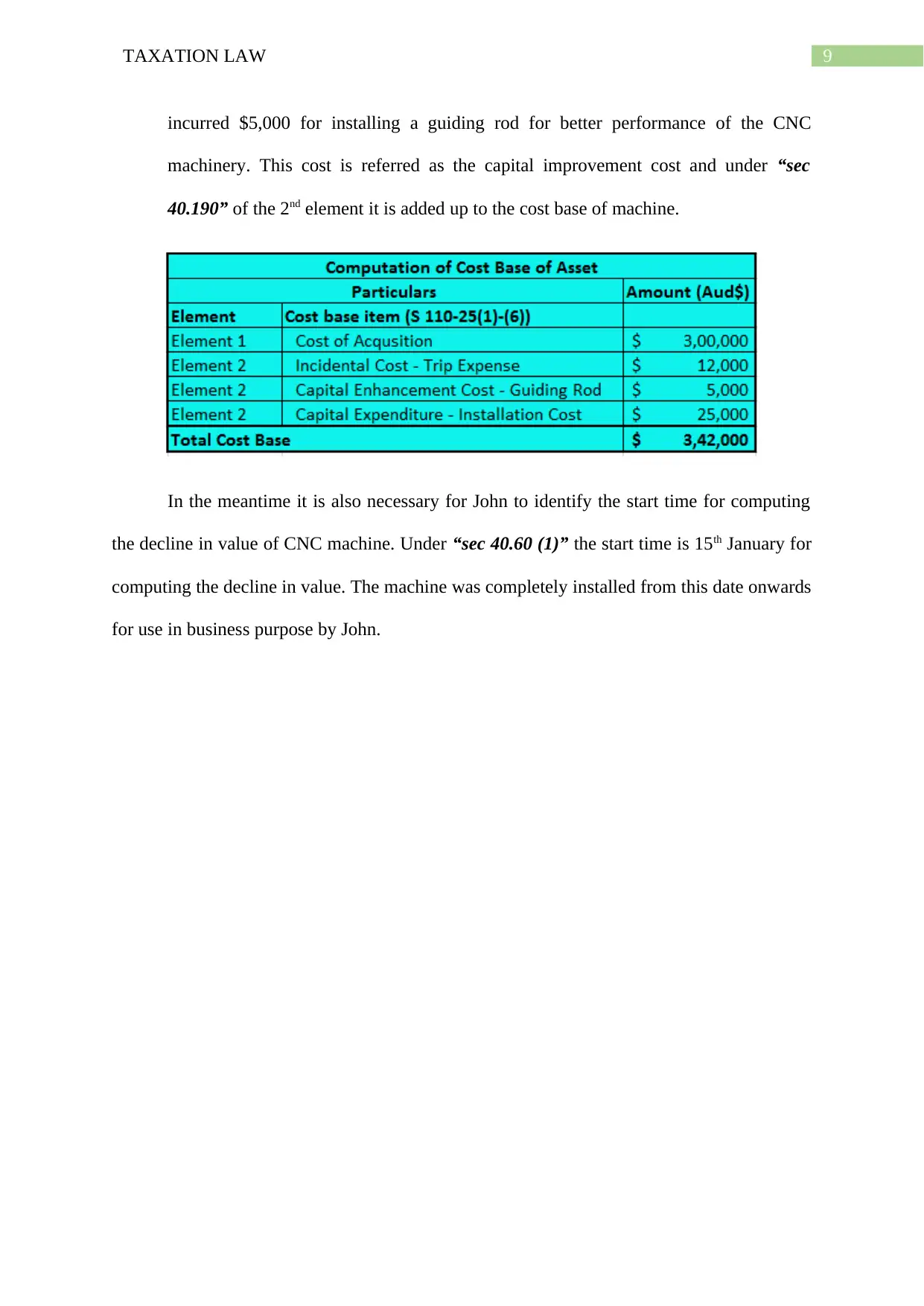
9TAXATION LAW
incurred $5,000 for installing a guiding rod for better performance of the CNC
machinery. This cost is referred as the capital improvement cost and under “sec
40.190” of the 2nd element it is added up to the cost base of machine.
In the meantime it is also necessary for John to identify the start time for computing
the decline in value of CNC machine. Under “sec 40.60 (1)” the start time is 15th January for
computing the decline in value. The machine was completely installed from this date onwards
for use in business purpose by John.
incurred $5,000 for installing a guiding rod for better performance of the CNC
machinery. This cost is referred as the capital improvement cost and under “sec
40.190” of the 2nd element it is added up to the cost base of machine.
In the meantime it is also necessary for John to identify the start time for computing
the decline in value of CNC machine. Under “sec 40.60 (1)” the start time is 15th January for
computing the decline in value. The machine was completely installed from this date onwards
for use in business purpose by John.
Paraphrase This Document
Need a fresh take? Get an instant paraphrase of this document with our AI Paraphraser
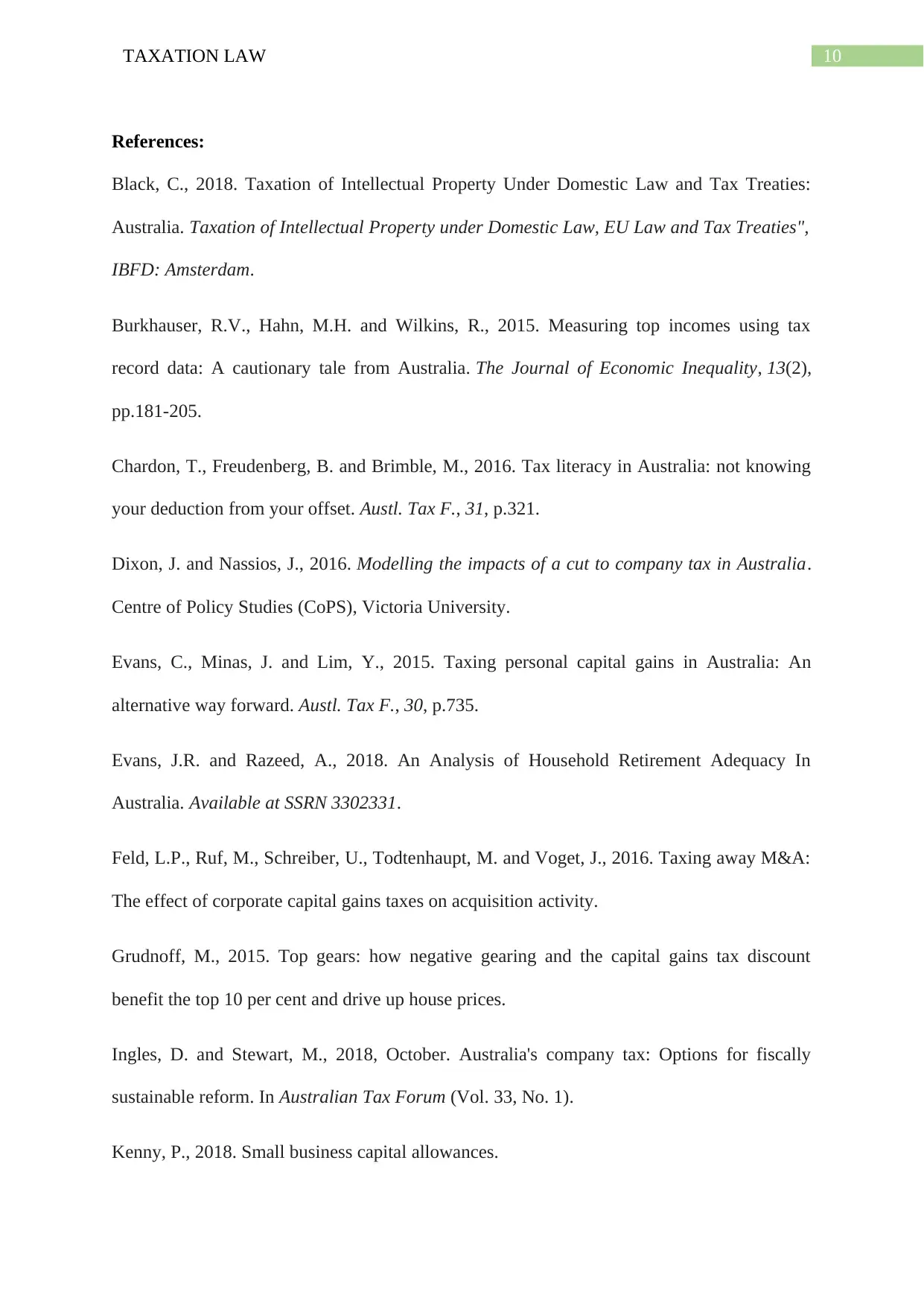
10TAXATION LAW
References:
Black, C., 2018. Taxation of Intellectual Property Under Domestic Law and Tax Treaties:
Australia. Taxation of Intellectual Property under Domestic Law, EU Law and Tax Treaties",
IBFD: Amsterdam.
Burkhauser, R.V., Hahn, M.H. and Wilkins, R., 2015. Measuring top incomes using tax
record data: A cautionary tale from Australia. The Journal of Economic Inequality, 13(2),
pp.181-205.
Chardon, T., Freudenberg, B. and Brimble, M., 2016. Tax literacy in Australia: not knowing
your deduction from your offset. Austl. Tax F., 31, p.321.
Dixon, J. and Nassios, J., 2016. Modelling the impacts of a cut to company tax in Australia.
Centre of Policy Studies (CoPS), Victoria University.
Evans, C., Minas, J. and Lim, Y., 2015. Taxing personal capital gains in Australia: An
alternative way forward. Austl. Tax F., 30, p.735.
Evans, J.R. and Razeed, A., 2018. An Analysis of Household Retirement Adequacy In
Australia. Available at SSRN 3302331.
Feld, L.P., Ruf, M., Schreiber, U., Todtenhaupt, M. and Voget, J., 2016. Taxing away M&A:
The effect of corporate capital gains taxes on acquisition activity.
Grudnoff, M., 2015. Top gears: how negative gearing and the capital gains tax discount
benefit the top 10 per cent and drive up house prices.
Ingles, D. and Stewart, M., 2018, October. Australia's company tax: Options for fiscally
sustainable reform. In Australian Tax Forum (Vol. 33, No. 1).
Kenny, P., 2018. Small business capital allowances.
References:
Black, C., 2018. Taxation of Intellectual Property Under Domestic Law and Tax Treaties:
Australia. Taxation of Intellectual Property under Domestic Law, EU Law and Tax Treaties",
IBFD: Amsterdam.
Burkhauser, R.V., Hahn, M.H. and Wilkins, R., 2015. Measuring top incomes using tax
record data: A cautionary tale from Australia. The Journal of Economic Inequality, 13(2),
pp.181-205.
Chardon, T., Freudenberg, B. and Brimble, M., 2016. Tax literacy in Australia: not knowing
your deduction from your offset. Austl. Tax F., 31, p.321.
Dixon, J. and Nassios, J., 2016. Modelling the impacts of a cut to company tax in Australia.
Centre of Policy Studies (CoPS), Victoria University.
Evans, C., Minas, J. and Lim, Y., 2015. Taxing personal capital gains in Australia: An
alternative way forward. Austl. Tax F., 30, p.735.
Evans, J.R. and Razeed, A., 2018. An Analysis of Household Retirement Adequacy In
Australia. Available at SSRN 3302331.
Feld, L.P., Ruf, M., Schreiber, U., Todtenhaupt, M. and Voget, J., 2016. Taxing away M&A:
The effect of corporate capital gains taxes on acquisition activity.
Grudnoff, M., 2015. Top gears: how negative gearing and the capital gains tax discount
benefit the top 10 per cent and drive up house prices.
Ingles, D. and Stewart, M., 2018, October. Australia's company tax: Options for fiscally
sustainable reform. In Australian Tax Forum (Vol. 33, No. 1).
Kenny, P., 2018. Small business capital allowances.
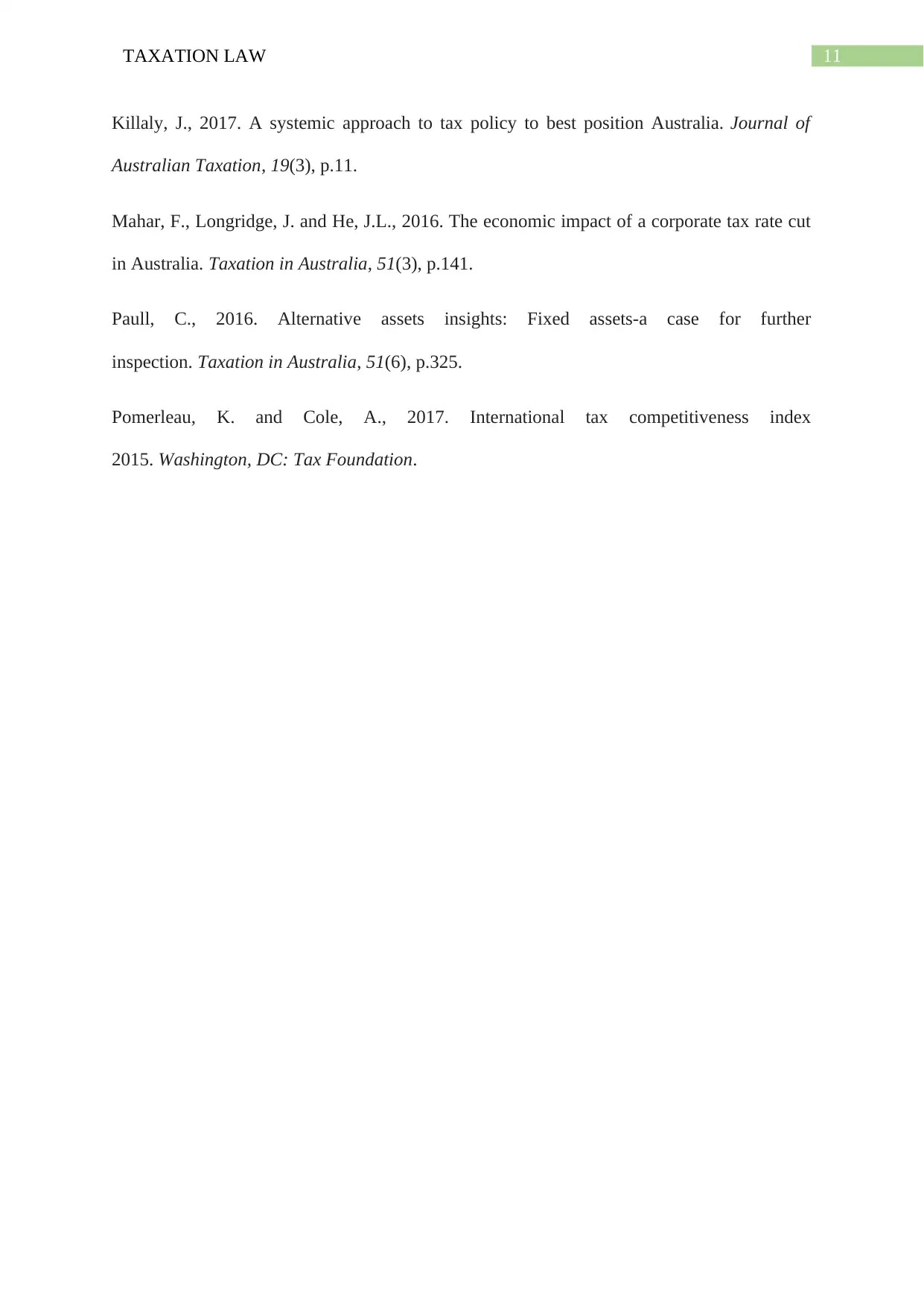
11TAXATION LAW
Killaly, J., 2017. A systemic approach to tax policy to best position Australia. Journal of
Australian Taxation, 19(3), p.11.
Mahar, F., Longridge, J. and He, J.L., 2016. The economic impact of a corporate tax rate cut
in Australia. Taxation in Australia, 51(3), p.141.
Paull, C., 2016. Alternative assets insights: Fixed assets-a case for further
inspection. Taxation in Australia, 51(6), p.325.
Pomerleau, K. and Cole, A., 2017. International tax competitiveness index
2015. Washington, DC: Tax Foundation.
Killaly, J., 2017. A systemic approach to tax policy to best position Australia. Journal of
Australian Taxation, 19(3), p.11.
Mahar, F., Longridge, J. and He, J.L., 2016. The economic impact of a corporate tax rate cut
in Australia. Taxation in Australia, 51(3), p.141.
Paull, C., 2016. Alternative assets insights: Fixed assets-a case for further
inspection. Taxation in Australia, 51(6), p.325.
Pomerleau, K. and Cole, A., 2017. International tax competitiveness index
2015. Washington, DC: Tax Foundation.
⊘ This is a preview!⊘
Do you want full access?
Subscribe today to unlock all pages.

Trusted by 1+ million students worldwide
1 out of 12
Related Documents
Your All-in-One AI-Powered Toolkit for Academic Success.
+13062052269
info@desklib.com
Available 24*7 on WhatsApp / Email
![[object Object]](/_next/static/media/star-bottom.7253800d.svg)
Unlock your academic potential
Copyright © 2020–2025 A2Z Services. All Rights Reserved. Developed and managed by ZUCOL.





